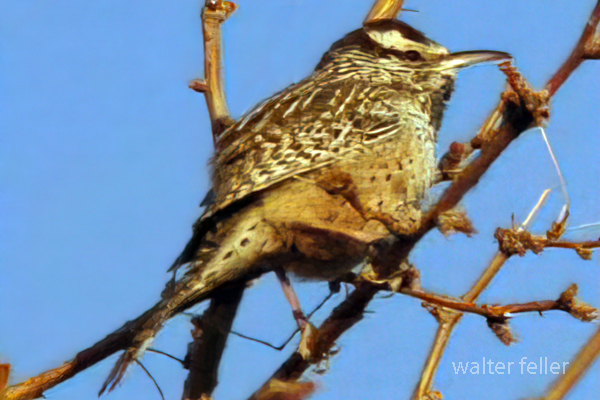Cactus Wren

The Cactus Wren (Campylorhynchus brunneicapillus) is a bird species native to the southwestern United States, Mexico, and parts of Central America. It is known for its distinctive appearance and behavior, particularly its preference for arid and desert habitats.
Here are some key characteristics and facts about the Cactus Wren:
Appearance:
The Cactus Wren is a medium-sized bird with a bold and distinctive appearance. It has a brownish overall coloration with bold black and white markings on its face, throat, and breast. Its long, slightly curved bill is adapted for foraging in arid environments.Habitat:
As the name suggests, the Cactus Wren is often associated with cactus-rich habitats, including deserts, arid scrublands, and areas with thorny vegetation. It can be found in a range of habitats, from lowland deserts to mountainous regions.Nesting:
Cactus Wrens build large, globular nests made of twigs, grass, and other plant materials. These nests are often placed in the protective thorny branches of cacti, providing shelter from predators. The nests can be quite intricate and are built by both the male and female birds.Diet:
The diet of the Cactus Wren consists mainly of insects, spiders, and other small invertebrates. They are skilled foragers, using their long bills to probe into crevices and search for prey.Vocalizations:
Cactus Wrens are known for their loud and distinctive calls. Their vocalizations include a series of chattering and rattling sounds. They are territorial birds and use vocalizations to communicate with each other and establish their presence in an area.Range:
The species is primarily found in the southwestern United States, including states such as Arizona, California, Nevada, New Mexico, and Texas. It also extends into northern Mexico and parts of Central America.Conservation Status:
The Cactus Wren is not considered globally threatened, and its population appears to be stable. However, local populations may face threats from habitat loss and changes in land use. Observing a Cactus Wren in its natural habitat can be a rewarding experience, especially in the unique landscapes of the desert regions where it thrives.
The cactus wren is the largest North American wren, and is 18-23 cm (7-9 inches) long.
Unlike the smaller wrens, the Cactus Wren is easily seen. It has the loud voice characteristic of
wrens, but its song is harsh and unmusical, and it is much less shy than most of the family. Its marked
white eyestripe, brown head, barred wings and tail, and spotted tail feathers make it easy to identify.
The Cactus Wren is native to the south-western United States southwards to central Mexico. It is a bird
of
arid
regions, and is often found around yucca, mesquite or saguaro; it nests in cactus plants,
sometimes in a hole in a saguaro, sometimes where its nest will be protected by the prickly leaves of a
cholla
or
yucca. It
mainly eats insects, though it will occasionally take seeds or fruits. It rarely drinks
water, getting its moisture from its food.
The Cactus Wren forms permanent pair bonds, and the pairs defend a territory where they live all through the year.
Life History Account
Cactus Wren
Campylorhynchus brunneicapillus
Family: Troglodytidae Order: Passeriformes Class: Aves
DISTRIBUTION, ABUNDANCE, AND SEASONALITY
A locally common resident in the Mojave and Colorado deserts, north from the Mexican
boundary to Inyo and Kern cos. Coastal race found in arid parts of westward-draining slopes
from San Diego Co. northwest to Ventura Co.; numbers reduced in recent decades.
Frequents desert
cactus shrub,
Joshua tree woodland, and
desert wash
habitats.
SPECIFIC HABITAT REQUIREMENTS
Feeding: Forages on ground and in low vegetation for insects, spiders, other small
invertebrates, cactus fruits, other fruits, nectar, and seeds (Bent 1948, Anderson and
Anderson 1973). Fruits make up 15-20% of annual diet; more than most U.S. wrens (Ehrlich
et al. 1988). Foraging behavior often regulated by heat stress (Ricklefs and Hainsworth
1968), necessitating retreat from exposed sites into shade of shrubs and trees.
Cover: Thickets of
xeric
vegetation provide cover and thermal relief. Nest used as roost
site (Anderson and Anderson 1957).
Reproduction: Nest usually built in cholla or other large, branching cactus, in yucca, or in
stiff-twigged, thorny shrub or small tree. Nest is an intricate, woven cylinder, usually placed
horizontally 1.2 to 1.5 m (4-5 ft) above the ground (Anderson and Anderson 1957).
Water: Drinks in winter (Anderson and Anderson 1963), but it is uncertain whether
drinking water is required.
Pattern: Frequents deserts and other arid terrain with thickets, patches, or tracts of larger,
branching cacti, stiff-twigged, thorny shrubs, and small trees (Grinnell and Miller 1944).
SPECIES LIFE HISTORY
Activity Patterns: Yearlong,
diurnal
activity.
Seasonal Movements/Migration: Not migratory.
Home Range: May be same as territory (Anderson and Anderson 1963).
Territory: Average territory was 1.9 ha (4.8 ac), varying from 1.2-2.8 ha (2.9-6.9 ac), in
Arizona (Anderson and Anderson 1973). May maintain territory yearlong (Anderson and
Anderson 1963).
Reproduction: Breeds from March into June. Clutch size 4-5, range 3-7 (Harrison 1978).
Two broods per season is common. Incubation 15-18 days, by female (Anderson and
Anderson 1960). Altricial nestlings fledge at 17-23 days, average 21 (Hensley 1959,
Anderson and Anderson 1960). Young may return to roost in nest after fledging. Young
become independent at about 1 mo after leaving nest; sometimes help feed young of later
brood (Harrison 1978).
Niche: Anderson and Anderson (1963) listed domestic cats,
roadrunners,
snakes, and
shrikes as
predators
of adults and nestlings. Austin et al. (1972) observed nestling predation
by
gopher snakes
and
whipsnakes. Frequent
interactions with curve-billed thrashers reported
by Anderson and Anderson (1963), including destruction of cactus wren roosting nests by
thrashers.
- California Department of Fish and Game